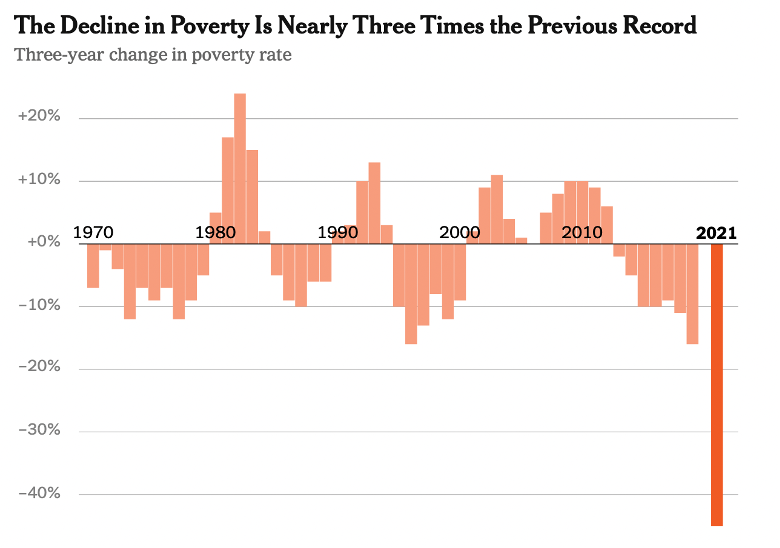If you want more content like this, subscribe to our newsletter.
This week in Class Notes:
- In contrast to past recessions, the COVID-19 recession led to more job losses and voluntary quits for women than for men.
- Subsidized broadband increases broadband adoption, employment, and earnings for low-income families.
- Skilled women in the U.S. are more likely to be married than unskilled women, unlike most other industrialized countries.
- This week’s top chart shows that pandemic aid programs led to a record 45% decline in the poverty rate.
- Adam Harris argues that we need better policies for promoting racial diversity in higher education, in this week’s choice op-ed.
- Check out our latest piece on why doubling the Pell Grant would make college more affordable for low-income students.
- For your calendar: attend virtual events on the impact of COVID-19 on children, helping foster kids transition to adulthood, and envisioning a more inclusive economic future.
- We’re hiring! We need a new Center Coordinator for the Center on Children and Families—pass the word.
In contrast to past recessions, the COVID-19 recession led to more job losses and voluntary quits for women than for men
The COVID-19 recession has often been labeled a “she-cession”, because unlike previous economic recessions, it has resulted in larger job losses among women than men. Women’s employment levels have fallen due to lost jobs in female-dominated occupations such as retail, as well as increased childcare pressures. In this paper, Stefania Albanesi and Jiyeon Kim use data from the Current Population Survey to analyze how much of the employment drop can be attributed to each of these shocks. They estimate that occupational distributions account for only about one-third of women’s employment losses between March and May 2020. Notably, occupation had little impact on the rise of non-participation for mothers with children, especially married mothers, relative to men. This suggests that many mothers voluntarily reduced their labor supply to increase their caregiving responsibilities at home. Indeed, evidence from labor market flows shows that women contributed to 85% of voluntary quits between June and November 2020. This highlights yet another challenge for women’s future work hours and employment, even as the economy begins to rebound.
Subsidized broadband increases broadband adoption, employment, and earnings for low-income families
Broadband internet access has grown over the last decade, but income-based disparities persist. Among families with incomes over $70,000 a year, 86% have broadband at home, compared to just 56% for families with incomes under $40,000. In this paper, George W. Zuo explores whether changes in broadband prices can reduce this gap and boost employment rates in low-income families. Zuo measures the impact of Internet Essentials, a discount broadband program launched by Comcast in 2012. Essentials offered subsidized broadband to over 6 million families with children qualifying for free or reduced-price lunch. Using data from the National Telecommunications and Information Administration as well as the American Community Survey, Zuo finds that the program increased broadband use among eligible families by 8%, reducing the income-broadband gap by 40%. Families that enrolled in the program were also 8 percentage points more likely to be employed and experienced a $147 increase in annual income. The employment effect is driven both by an increase in the labor force participation and the decreased likelihood of being unemployed.
Skilled women in the US are more likely to be married than unskilled women, unlike most other industrialized countries
Marriage rates throughout the industrialized world have been in decline for over half a century. In 2015, 20% of U.S. adults ages 35-44 had never married, compared to about 7% in 1970. In most countries, skilled women have married at lower rates than unskilled women. In the United States, however, skilled women are now more likely to be married than unskilled women. In their new paper, Marianne Bertrand and her co-authors explain this reverse trend using a theoretical model that describes the relationship between marriage rates, women’s skill levels, labor force opportunities, and gender norms. They argue that as labor market opportunities grow for skilled women, their marriage rates decline relative to unskilled women because their opportunity cost of having children is higher. This makes them less attractive in the marriage market, where gender norms dictate that women should play a large role in the provision of children. However, at high wage levels, the benefit of a higher family income outweighs the opportunity cost of having children, making high-income, skilled women relatively more attractive in the marriage market.
Top chart: Pandemic aid programs lead to a record 45% decline in the poverty rate
This week’s top chart shows that in 2021, the United States experienced a record 45% decline in the poverty rate—almost three times the previously largest drop. Between 2018 to 2021, the poverty rate fell from 13.9% to 7.7%, in large part due to pandemic aid programs like the strengthened child tax credit.

Choice opinion: We need better policies for promoting racial diversity in higher education
“Affirmative action has been a veil obscuring the truth about American higher education. It has never been that hard to see through, for those who tried, but removing it could force the nation at large to recognize the disparities in our system, and to search for better mechanisms to make college equitable,” writes Adam Harris.
Self-promotion: Doubling the Pell Grant would make college more affordable for low-income students
The Pell Grant is the largest grant-based component of federal financial aid for higher education. To ensure that a college education remains affordable for students from low-income families, Phillip B. Levine argues that we should double the maximum value of the Pell Grant, currently $6,495. After accounting for other forms of financial aid, Levine estimates that the current Pell value would leave a student from a family in the 25th percentile of the wealth distributions with an outstanding balance of $14,100 if they attend a public flagship school. “There is no good answer as to how students are supposed to pay the bill left over after financial aid is taken into account,” writes Levine. If the maximum Pell Grant were doubled to $13,000, low-income students’ unmet financial needs could in many cases be reduced to $0.
For your calendar: virtual events examining COVID’s impacts on children, ways to help foster kids transition to adulthood, and policies for a more inclusive economic future
What we know about kids and COVID-19
Thursday, September 9, 2021 1:00 PM EDT
The New York Times
On their own two feet: Helping foster youth transition to adulthood
Monday, September 13, 2021 12:00 PM–1:30 PM EDT
American Enterprise Institute
Evidence for a stronger economic future
September 20, 2021 – September 21, 2021
Washington Center for Equitable Growth
We are hiring a Center Coordinator for the Center on Children and Families
The Center Coordinator provides administrative, project, and communications support to the Center on Children and Families, working closely with the Director, Kristin Butcher, and senior staff to coordinate all Center activities, deadlines, and deliverables, and provide some direct administrative assistance. If you are interested or know someone that might be, you can find more details in the job posting. Please share this with your professional networks!








Commentary
Class Notes: The poverty rate, subsidized broadband internet, and more
August 26, 2021